eCommerce: MercadoLibre Marketplace
MercadoLibre Business Model: Revenue, Market Share, Growth
MercadoLibre does more than just run a marketplace. Discover how the company drives revenue, boosts market share, and leads growth in its home regions.
Article by Cihan Uzunoglu | September 25, 2024Download
Coming soon
Share
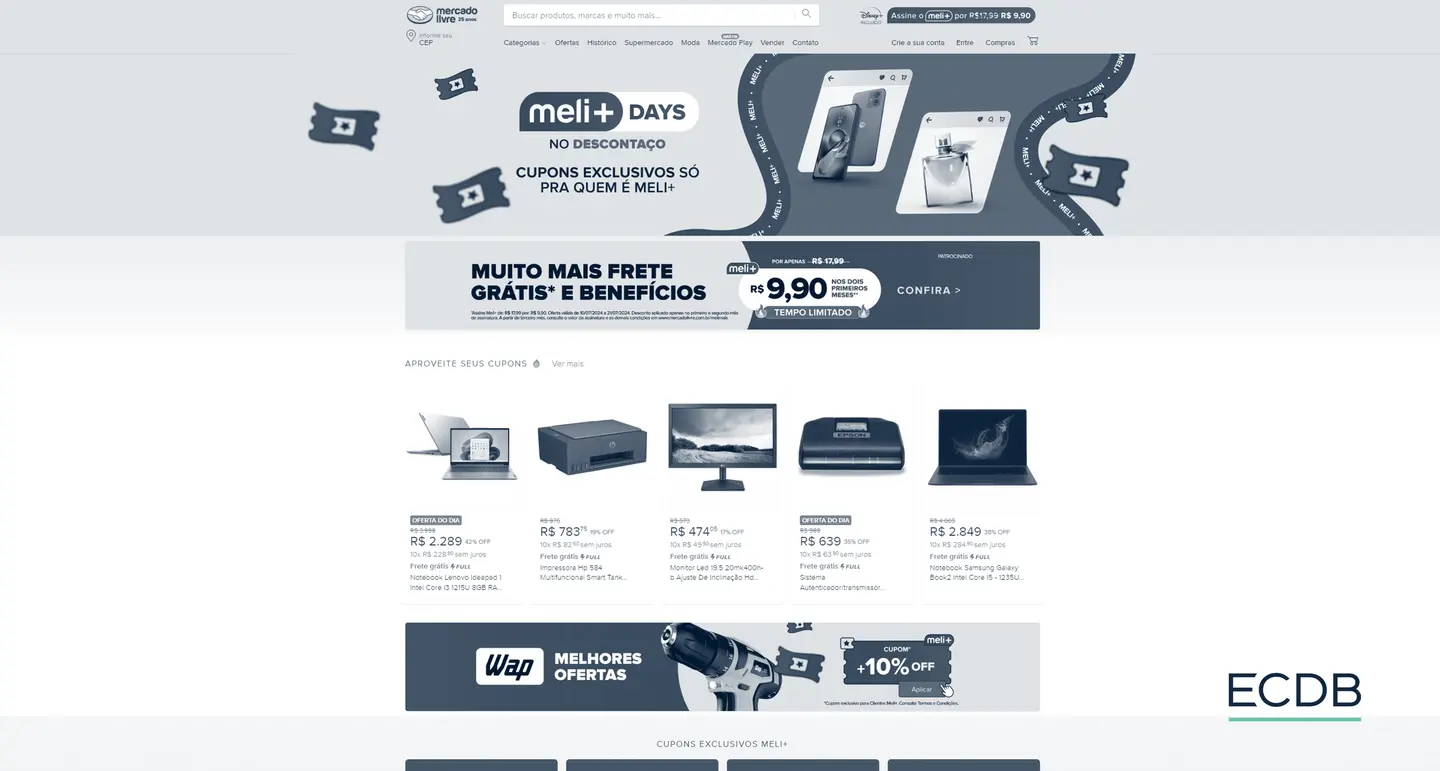
MercadoLibre Business Model: Key Insights
Fast Development: Founded in 1999, MercadoLibre has diversified across Latin America and beyond, leading in global consumer-to-consumer app downloads and boasting a rising Gross Merchandise Volume.
Strongholds in Key Markets: The company's 2023 GMV is primarily anchored in Brazil, Argentina, and Mexico, with key product categories including Electronics, Grocery & Fashion.
Fintech Revolution: In Q1 2024, fintech services contributed nearly 42.5% of MercadoLibre's revenue, showcasing its evolution beyond an online marketplace.
Growth Trends: While the firm's user numbers and sales continue to rise, the pace of its growth is moderating, indicating a potential period of stabilization.
Against Global Giants: Despite global competitors like Amazon and AliExpress entering the Latin American market, MercadoLibre's local expertise maintains its leading position.
Imagine an eCommerce giant that not only leads in Latin America but also competes with global powerhouses like Amazon: Meet MercadoLibre.
The company started by selling goods from its own inventory and has since expanded into in digital payments and financial services, and even explored digital streaming.
Since its NASDAQ listing in 2007, MercadoLibre has seized new opportunities, growing into a major global player. By dominating key markets like Brazil, Argentina, and Mexico, it has expanded beyond retail into Fintech and logistics.
MercadoLibre Outperformed Amazon
MercadoLibre has become a top choice for investors seeking tech opportunities beyond the "Magnificent Seven." Its stock is up 34% in 2024, outperforming Amazon and the S&P 500. Founded 25 years ago by CEO Marcos Galperin, the company dominates online sales in Brazil, Argentina, Mexico, and Chile, holding about half of South America's eCommerce market.
MercadoLibre also operates Mercado Pago, its digital payments service. Wall Street is bullish on the stock, with 90% of analysts rating it a "buy." Investors like Brad Gerstner are optimistic about the company's growing profit margins and AI potential.
Galperin conceived MercadoLibre while studying at Stanford, where he recognized the lack of infrastructure in Latin America as an opportunity. The company initially partnered with eBay but has since pivoted to a model more like Amazon’s.
MercadoLibre’s growth is fueled by Latin America’s young, mobile-savvy population. The company saw a 42% revenue jump in Q2, with an operating profit margin of 14.3%. Galperin believes there’s still huge potential, especially with half the region's population being unbanked or underbanked.
MercadoLibre Expansion
Established in 1999, MercadoLibre has carved out a distinct space for itself in Latin America's online retail sector. Operating on a hybrid business model, the company sells goods both from its own inventory and via third-party sellers, while offering a wide array of products, from Electronics and Grocery items to Fashion, Care Products and Hobby & Leisure.
Initially launching operations in Brazil, Argentina, Mexico, and Uruguay, the company expanded into Ecuador, Chile, Venezuela, and Colombia in the early 2000s. It strengthened its Brazilian operations by acquiring iBazar Como in 2001 and introduced Mercado Pago, a digital payment platform, in 2003. More on that later.

As we reach the mid-2000s, the online marketplace continued its expansion. By 2006, MercadoLibre had also entered Costa Rica, Panama, and the Dominican Republic. After its NASDAQ listing in 2007, MercadoLibre moved into the automotive and real estate sectors by acquiring Tu Carro and Tuinmueble in 2008.
The company improved its logistics with the 2013 launch of Mercado Envíos and expanded its real estate holdings in 2014 with multiple acquisitions. MercadoLibre diversified further in 2017 by launching Mercado Credito, a financial services arm. This growth persisted into 2021, highlighted by a move to raise capital through the sale of shares, known as an equity offering, and the acquisition of Kangu, a Latin American logistics operator.
A Global Force: MercadoLibre Leads Global C2C Apps
As a marketplace, MercadoLibre's dominance is clear not only in Latin America, but also globally. According to data from AppMagic, MercadoLibre is the leading consumer-to-consumer (C2C) app worldwide. With over 90 million downloads on the App Store and Google Play Store, the marketplace tripled its closest contender, Vinted, while dwarfing the likes of eBay and OLX.
Data published by CompaniesMarketCap shows that MercadoLibre has the fifth highest market cap (US$87.61 billion) among the leading eCommerce companies worldwide as of July 2024, only behind Amazon, Pinduoduo, Alibaba and Meituan.
MercadoLibre GMV Development
On that note, let's take a quick look at the development of MercadoLibre's Gross Merchandise Volume (GMV) to have a better understanding the company’s progress through the years.
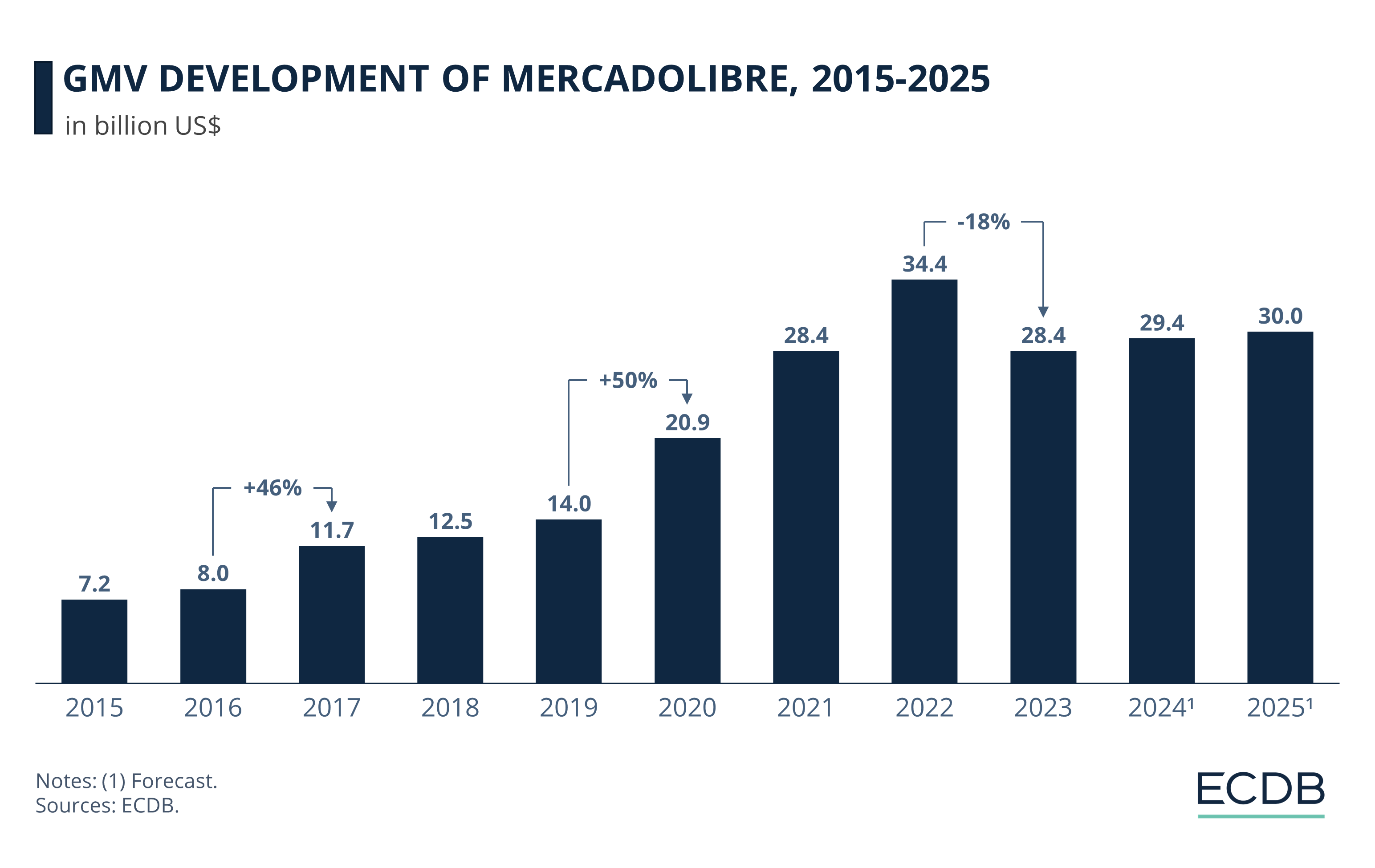
In 2015, the marketplace GMV stood at US$7.2 billion, which climbed to US$8 billion in 2016.
The subsequent year, 2017, marked a notable surge, growing to US$11.7 billion — a 46% growth compared to the previous year.
While the GMV generally trended upward in the subsequent years, reaching US$14 billion in 2019, the year 2020 brought another substantial increase, catapulting the figure to US$20.9 billion at a 50% growth rate.
Fast-forward to 2022, the GMV had further escalated to US$34.4 billion. This was followed by a 18% degrowth next year, resulting in a GMV of US$28.4 billion in 2023.
Forecasts for this year and next show modest increases in GMV: US$29.4 billion, followed by US$30 billion.
MercadoLibre GMV Strongly Concentrated in Brazil, Argentina, and Mexico
MercadoLibre's distribution of 2023 GMV reveals a strong focus on key markets, particularly emphasizing the company's commanding presence in Brazil, Argentina, and Mexico.
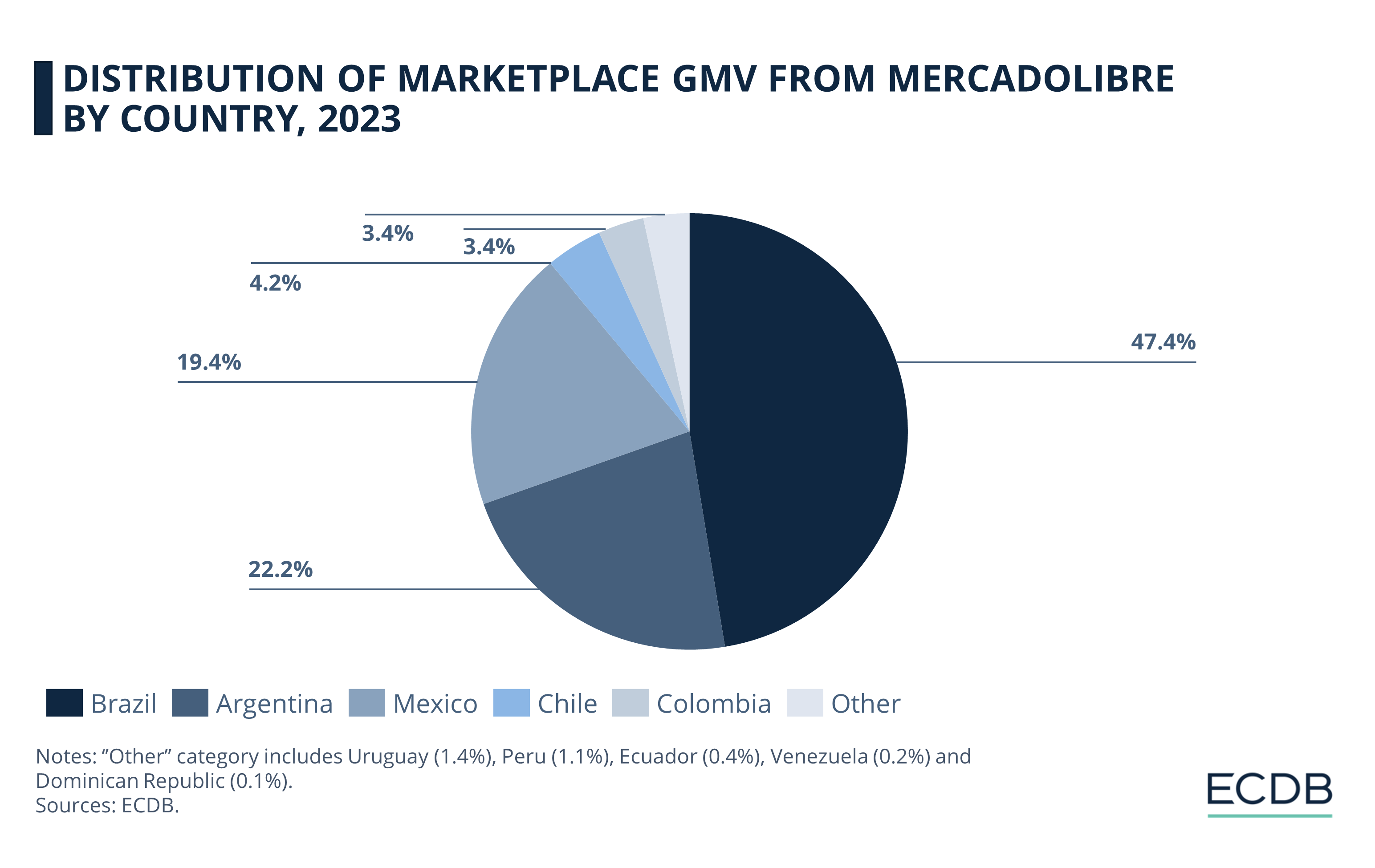
Brazil leads with approximately 47.4% of the marketplace's GMV, while Argentina comes in second at about 22.2%.
Mexico also holds a significant position, contributing 19.4% to the GMV.
Meanwhile, Chile and Colombia show moderate activity, generating 4.2% and 3.4% respectively.
Countries with smaller shares — namely Uruguay, Peru, Ecuador, Venezuela and Dominican Republic — are not dominant but remain part of MercadoLibre's diverse geographic landscape.
Top MercadoLibre Product Categories:
Electronics, Grocery & Fashion
According to our data, Electronics is the product category that makes up the largest share of MercadoLibre's GMV:
Electronics with 25.8% is followed by Grocery at 19.4%.
Fashion is another key category, representing 13.7% of the company's GMV.
Care Products account for 11.6%, and the DIY category closely follows at 11.5%.
Additionally, Hobby & Leisure items represent 11.4% of the GMV and Furniture & Homeware is at 6.5%.
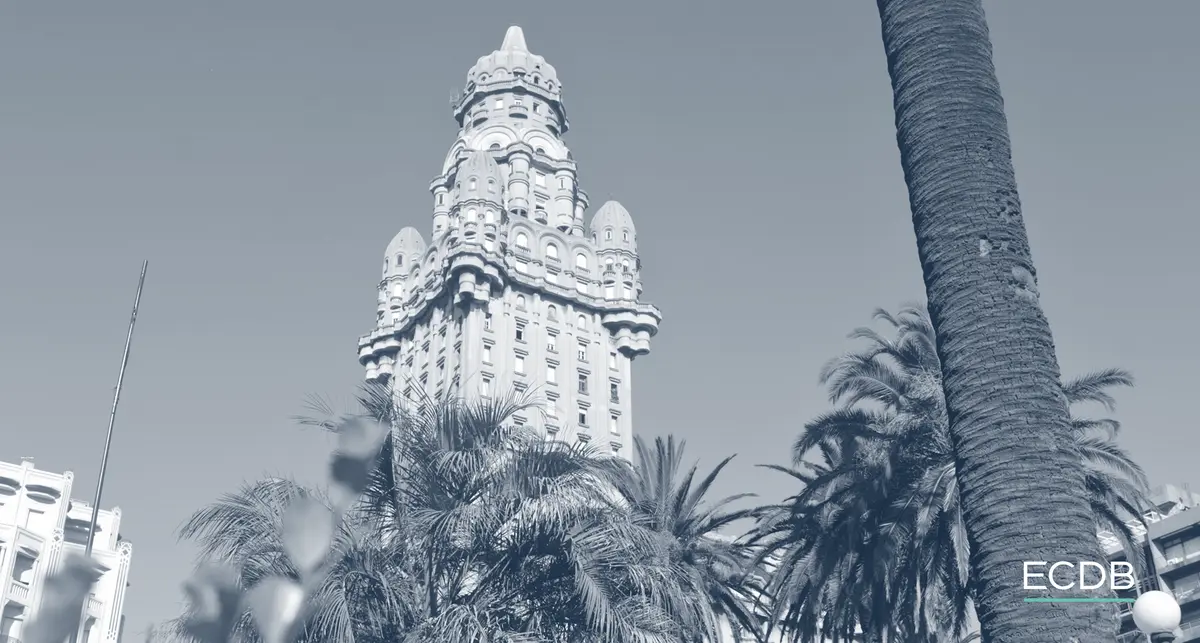
MercadoLibre: More Than a Marketplace
The company's ambitions stretch far beyond eCommerce: it is a Fintech powerhouse in its own right.
Fintech Contributes Almost Half of Q1 2024 Revenue
Through Mercado Pago, MercadoLibre's comprehensive financial arm, the company has established its own digital bank, launched credit card services, and offered payment terminals to businesses ranging from small enterprises to larger operations.
The service has a footprint in countries including Argentina, Brazil, Chile, Colombia, Mexico, Peru, Uruguay, and Venezuela. The extent of Mercado Pago's reach is underscored by its financials – almost US$1.84 billion of the company's US$4.33 billion revenue for Q1 2024 came from this Fintech offshoot, making up nearly 42.5% of the total.
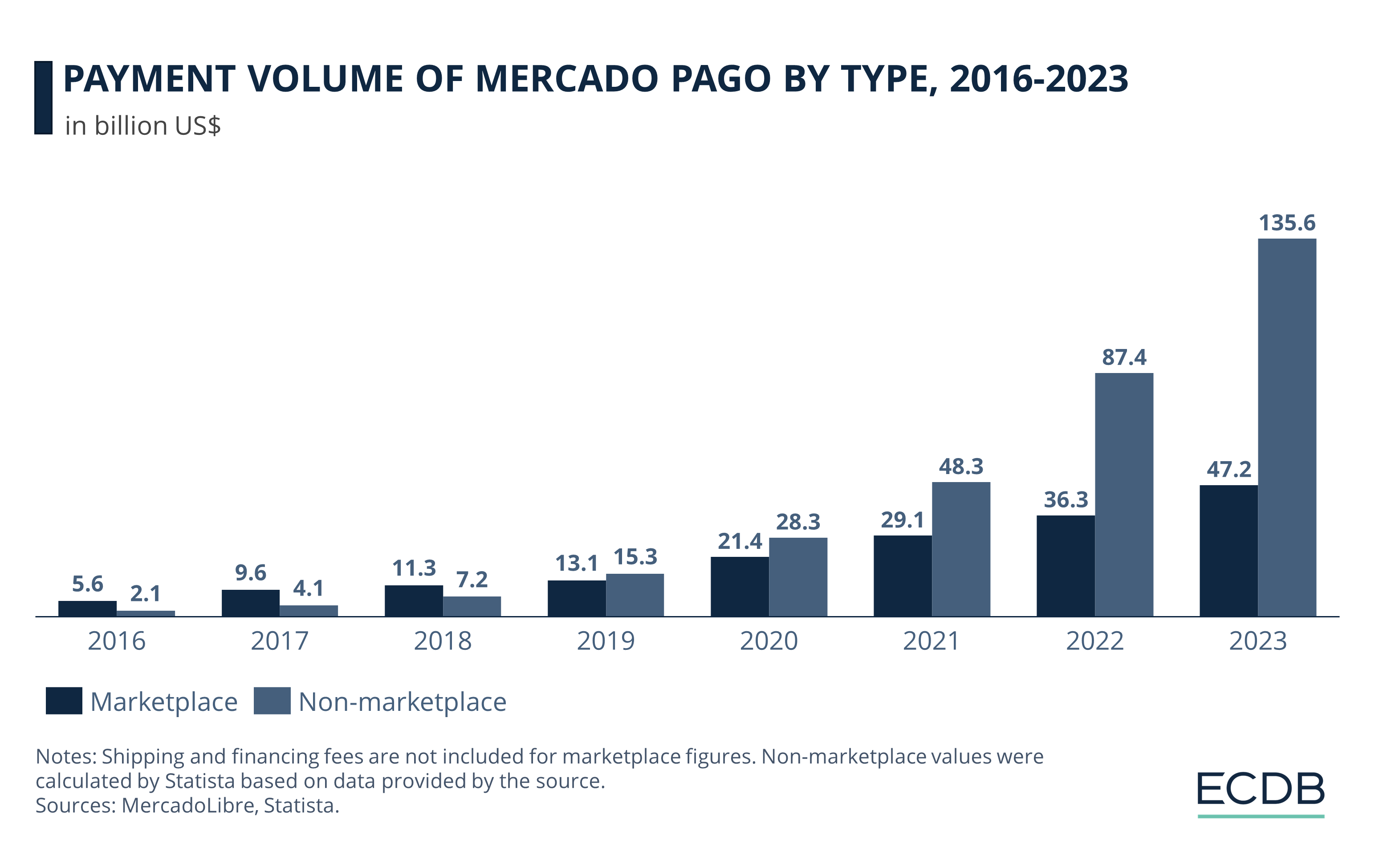
Last year, the platform processed about US$135.6 billion in payments to businesses outside of its online marketplace, primarily small and medium-sized enterprises. In addition, Mercado Pago handled over US$47 billion in transactions on its marketplace, excluding shipping and financing fees.
The user base of the payment service is also expanding. The number of unique active Fintech users in Q4 2023 increased by 21.3% year-on-year, reaching 53 million, surpassing 50 million users for the first time.
Moreover, Mercado Pago has cautiously curtailed new loans, particularly as inflationary pressures mount in the region, showing the company's financial prudence in a fluctuating economic landscape.
MercadoLibre’s Streaming Efforts
As MercadoLibre broadens its focus beyond retail, financial services, and into new consumer territories, its pursuit of diversification becomes even more pronounced. The most recent additions to its sprawling offerings are Mercado Play, its digital streaming service, and Meli+, an expansive subscription program.
Available in Mexico and Brazil so far, Meli+ lets subscribers amplify both their shopping and entertainment experiences. Not only does the program offer perks like free shipping and scheduled deliveries, but it also provides access and discounts to various streaming platforms, including its own, Mercado Play.
Enhanced Logistics, Faster Deliveries
Another space MercadoLibre is making significant strides in is the logistics sector, focusing on speedier delivery times that outpace its competitors. The company has even gone so far as to open new distribution facilities aimed at enabling same-day deliveries in key metropolitan regions.
Last year, Mercado Envíos, the firm's dedicated shipping arm, transported nearly 1.4 billion goods — a substantial leap from the 151 million articles conveyed in 2017. As of last year, this logistics service extended its reach to countries including Argentina, Brazil, Chile, Colombia, Mexico, Uruguay, and Venezuela.
MercadoLibre's Competitors in Latin America
Latin America’s eCommerce market is a booming one with a promising future. Per projections from Statista's Digital Market Outlook, the number of eCommerce users in Latin America hit around 266 million in 2023. This tally is set to climb 57% by 2029, amounting to roughly 419 million users in the region.
Of course, big names in retail are taking notice of this, too.
Amazon in Latin America
In Latin America, Amazon holds a formidable yet secondary position in the eCommerce sphere when juxtaposed with MercadoLibre. Despite racking up 92 million monthly visits in Brazil and 73 million in Mexico, Amazon falls behind MercadoLibre, which garners nearly four times the web traffic in the region. Moreover, these metrics constitute a mere 3% of Amazon's global footprint — a far cry from its U.S. and European strongholds.
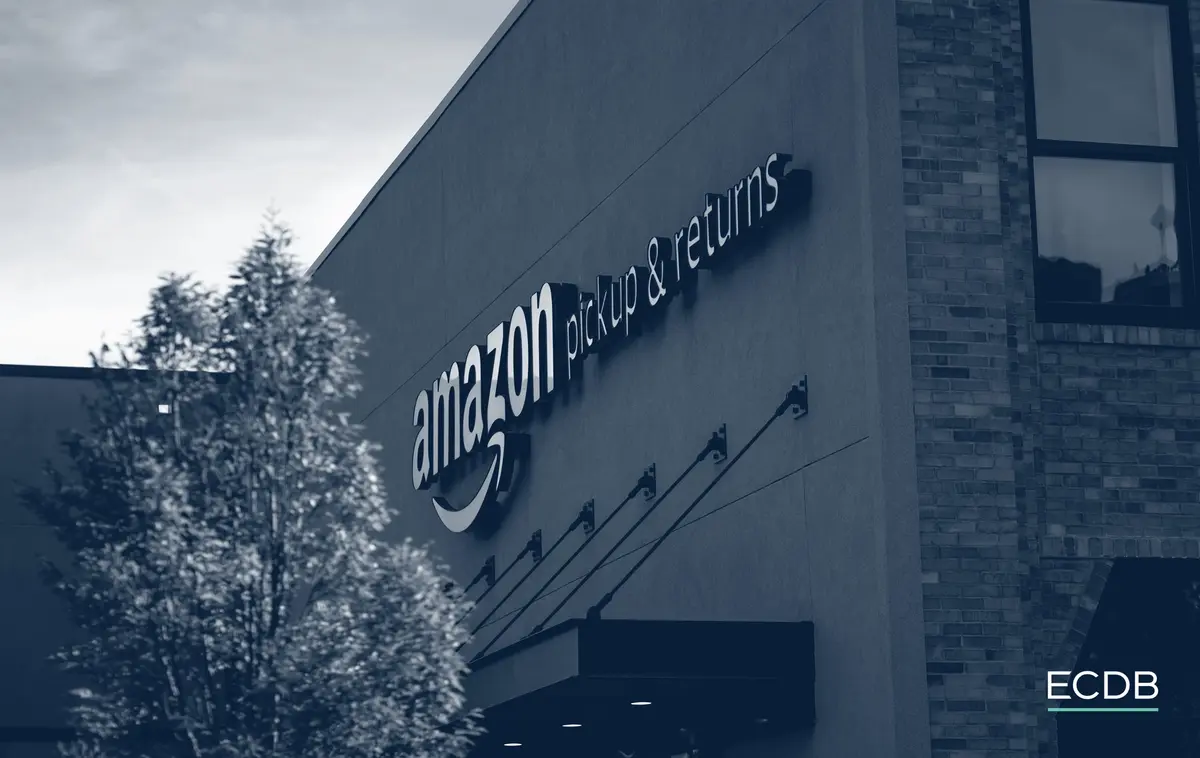
Amazon's foray into Latin America began in earnest with its expansion into Mexico in 2015, followed by a Brazil launch in 2017. The U.S.-based eCommerce leviathan has invested approximately US$3 billion in Mexico alone, aimed at bolstering its presence in the country's vibrant economy and taking on competitors like MercadoLibre and Walmart. The latest installment in this expansion strategy is a new delivery center in Mexico City, a sprawling facility that spans over 30,000 square meters and stands as Amazon's largest last-mile warehouse in Latin America.
The focus on Mexico is strategic: the country is home to about 40 Amazon warehouses and employs over 8,000 people directly while providing indirect employment to an additional 32,000. The Mexico City center is an extension of Amazon's broader strategy to locate distribution facilities closer to its customer base, particularly in populous urban areas; Mexico City alone has an estimated 22 million residents.
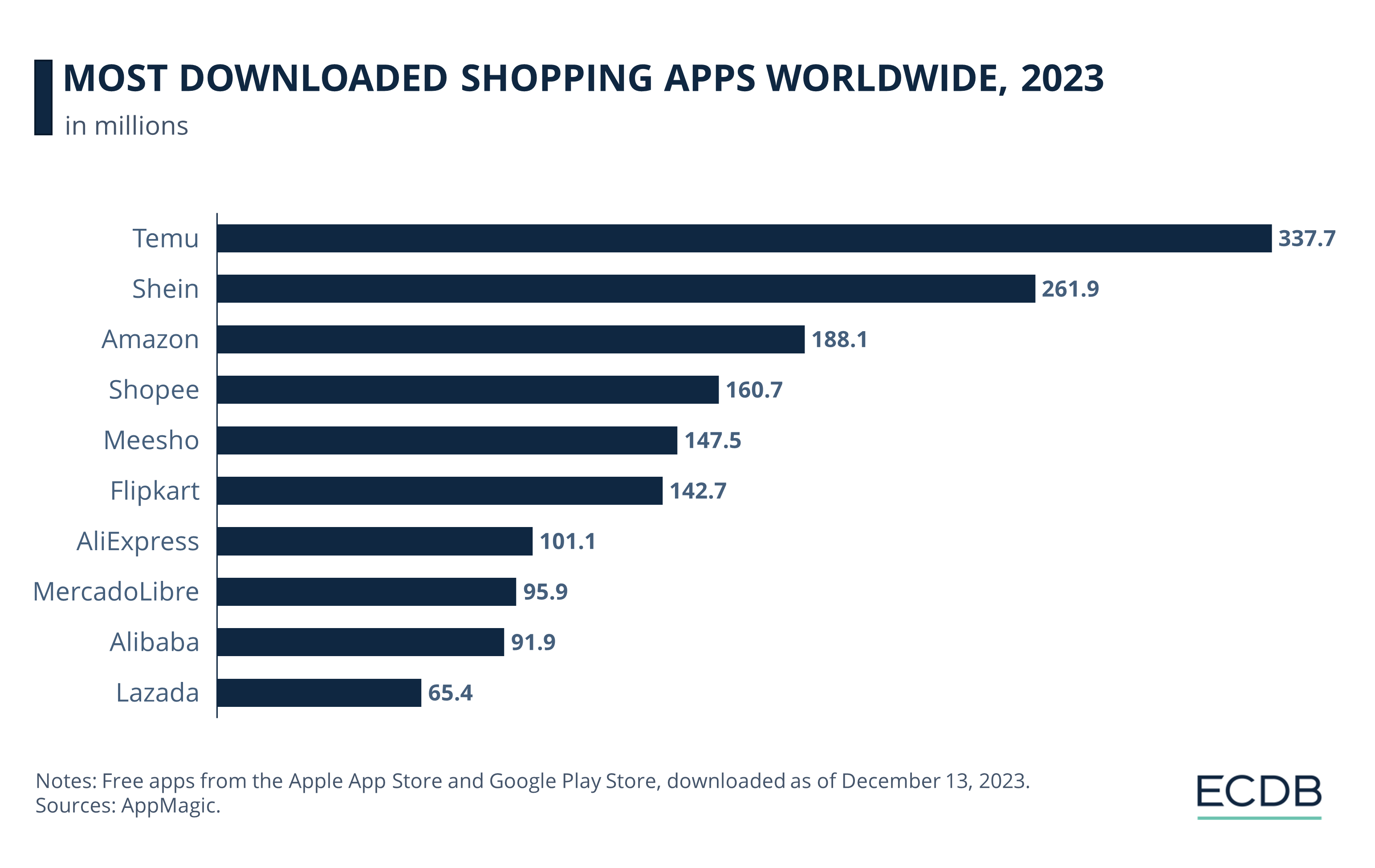
With 96 million downloads, MercadoLibre was the 8th most downloaded shopping app last year.
Amazon's Latin American strategy also includes Brazil, where the firm faces significant logistical challenges due to complex shipping regulations. Sellers from the U.S. and Canada can tap into these markets via Amazon's unified account system, although navigating Brazil's shipping environment requires special attention due to its complex and stringent shipping regulations.
Yet, Amazon's international reach has its limitations. Financial reports indicate that a mere quarter of Amazon's retail revenue is generated outside North America, a decline from approximately half in 2008. Despite strong competition in global markets such as the Middle East and India, Amazon has not been able to replicate its domestic retail success overseas.
However, it's worth noting that Amazon does maintain a robust global presence through Amazon Web Services (AWS), its cloud computing arm. In many Latin American circles, AWS is more recognized than Amazon's retail division, underscoring the challenges in scaling a logistics-heavy business model across diverse international markets.
AliExpress in Latin America
While Amazon navigates a competitive landscape in Latin America, particularly against MercadoLibre, another global player is gaining ground in the region: AliExpress, the international arm of China's eCommerce giant Alibaba. Compared to Amazon, AliExpress has been executing a multi-faceted strategy to expand its footprint, especially in Brazil.
Founded in 2010 as Alibaba's gateway to international markets, AliExpress entered Brazil in 2013 when eCommerce was still nascent in the country. Over the years, the platform has honed various strategies to deepen its roots in Latin America. In 2021, AliExpress introduced a dedicated portal to support Brazilian small and medium-sized enterprises, a move that resonates with the local business ecosystem.
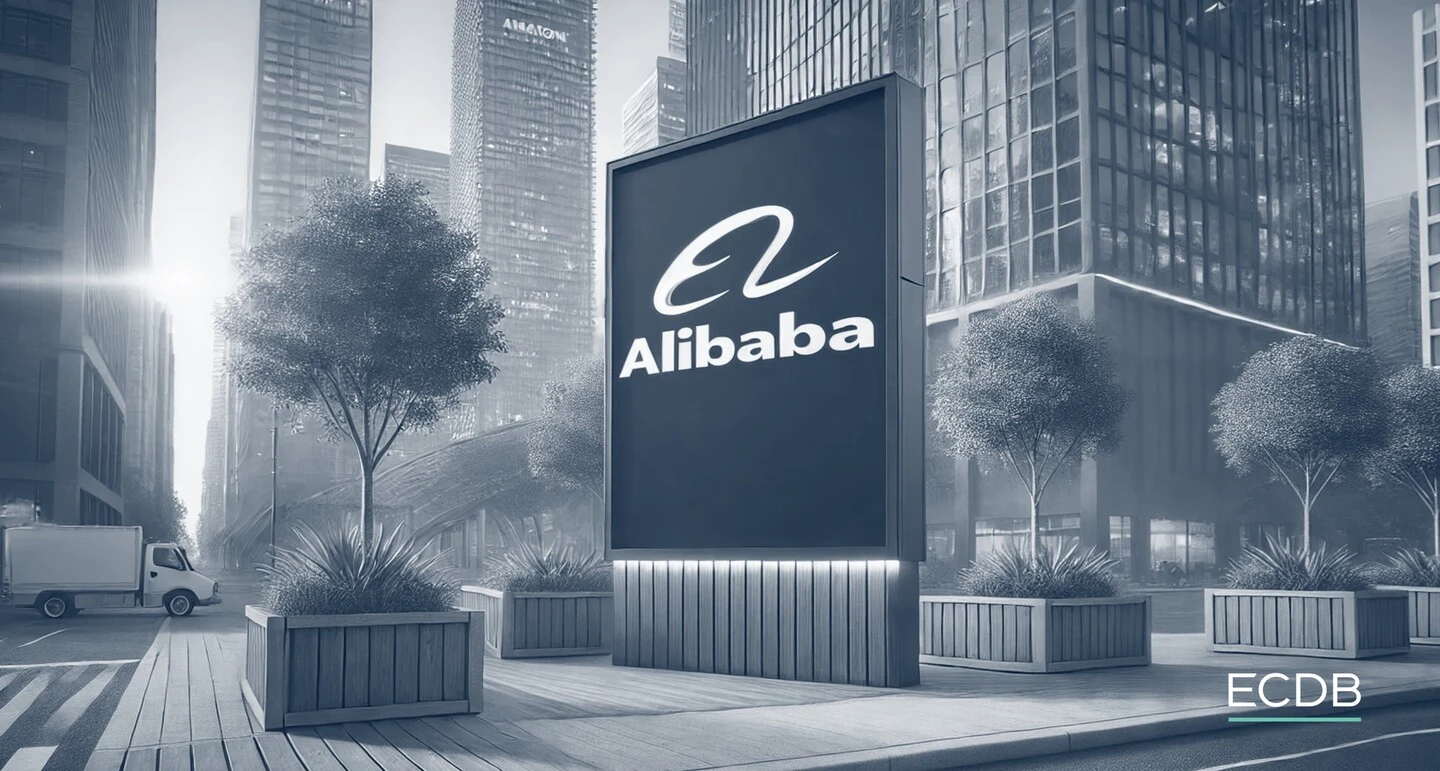
AliExpress's logistical ambitions are largely propelled by Cainiao, Alibaba's logistics subsidiary. Cainiao has been expanding aggressively in Latin America, setting up its regional headquarters in São Paulo, Brazil. The logistics arm plans to establish nine distribution centers in Brazil's key southeastern states over the next couple of years. In Mexico, a strategically located distribution center has been opened to reduce shipment times from China to just 12 business days.
Cainiao is not merely a courier for AliExpress; it is also venturing into providing local courier services. The logistics giant's network currently spans over 1,000 Brazilian cities, and it aims to expand this reach by adding 1,000 more lockers in 10 cities in Brazil. Similar to Amazon's focus on last-mile delivery, Cainiao seeks to place its logistics infrastructure closer to customers, albeit with a twist: the use of "smart lockers" that offer customers a convenient parcel pickup option.
While Amazon faces logistical challenges in Brazil due to complex shipping regulations, AliExpress and Cainiao seem to be capitalizing on their international logistics experience. Cainiao already operates eight weekly chartered flights between China and Brazil and aims to add more routes, signaling the company's commitment to streamlining its logistics efforts in the region.
Sources: AppMagic, Mercado Pago, MercadoLibre, Fintech Nexus, Investing, Fashion Network, Web Retailer, Reuters, World Population Review, EqualOcean, KrASIA, SiiLa, CNBC, TechCrunch, CompaniesMarketCap, BNamericas, Statista, ECDB

Click here for
more relevant insights from
our partner Mastercard.
Related insights
Deep Dive
YouTube Partners With Flipkart and Myntra to Launch YouTube Shopping in India
YouTube Partners With Flipkart and Myntra to Launch YouTube Shopping in India
Deep Dive
Kaspi to Acquire Stake in Hepsiburada, Expanding Presence in Turkey
Kaspi to Acquire Stake in Hepsiburada, Expanding Presence in Turkey
Deep Dive
Jumia Business Analysis: Top Markets, Revenue, GMV & eCommerce in Africa
Jumia Business Analysis: Top Markets, Revenue, GMV & eCommerce in Africa
Deep Dive
Temu Is the Second Most Visited eCommerce Website in the World
Temu Is the Second Most Visited eCommerce Website in the World
Deep Dive
Indonesia Urges Apple and Google To Restrict Temu
Indonesia Urges Apple and Google To Restrict Temu
Back to main topics